Building-integrated photovoltaics (BIPV) is exactly what the name indicates: solar power generation modules that are integrated directly into a building in the place of ordinary building materials. BIPV differs in a number of ways from the PV arrays that most of us are familiar with: the roof-mounted or rack-mounted PV arrays that are retrofitted onto homes and produce electricity for domestic consumption or to be fed into the electricity grid. These bulky, rectangular structures usually made of mono- or poly-crystalline cells are what most of us imagine when we think of solar power because these are by far the most tried-and-true and therefore most common and trusted forms of solar power generation. This article explains in more detail what BIPV is and discusses the future trajectory of the photovoltaics industry towards increasing uptake of BIPV.
Conventional Solar PV Panels: A bit of background
As Mike Tomassi, International Business Development Director of System Photonics explained in a talk he gave at the Solar in Building Design and Construction (SBDC) Conference held in London 24 Sept 2010, the solar modules that we think of as ‘conventional’ were never intended to be used as building components. Instead, they have been designed for power conversion efficiency and price competitiveness. Fortunately, their sturdiness and modularity, plus the industry’s history and experience working with them, means that these modules can be retrofitted onto older homes with relative ease and significant confidence that they will function properly. Nevertheless, it would be difficult to find proponents of these panels for their aesthetics. One of the main criticisms ordinarily levelled against solar panels (by architects, at least) is their unsightly appearance. On top of their visually unappealing nature, several functional issues make them less than ideal: they are difficult to make waterproof, they aren’t designed to be self-cleaning, and most of them were not manufactured with the idea of future recycling in mind. Future advances in the solar power industry will deal with these issues and ensure that modules can be smoothly integrated into design and construction: BIPV.
What, then, are the criteria for PV cells to be considered BIPV instead of conventional solar panels? Mike Tommasi uses France as an example of a country with simple, intuitive yet stringent requirements: to access the most generous feed-in tariff there, BIPV modules must meet the standards for and perfectly serve the function of the part of the building that they are meant to replace. If a module is designed to be a roof tile, for example, then when it is removed, the roof should leak when it rains. The purpose of a roof tile, after all, is to keep the rain out. It should also meet all the other requirements and standards that roof tiles are ordinarily subject to: they must be durable and resistant to wind, they should prevent the accumulation of dirt, and they should be ‘walkable’ so that ordinary roof maintenance can be carried out when needed. If all of these criteria are not met, then the module fails to be a good rooftop BIPV.
Given these requirements for functional flexibility, and the fact that in many cases BIPV is used for parts of a building that may not be ideally situated for full solar irradiation, it is not a surprise that this is where amorphous/thin film PV, is more malleable and less subject to inefficiencies due to shading and heating, comes into its own. Many of the technologies discussed here utilise amorphous PV for this reason. (For further reading on BIPV applications of amorphous solar panels, please refer to Miwa Tominaga’s Master’s Dissertation in the references section at the bottom of this article.)
BIPV: Energy efficiency teams up with energy generation
Renewable energy only makes sense when paired with energy efficiency. The recent 200 or so years’ abundance of fossil fuels has made power generation cheap and plentiful, leaving significant room for improvement in terms of how we use our energy. It is often said that energy efficiency is the ‘low-hanging fruit‘ of tactics for decreasing global reliance on fossil fuels. There are plenty of ways to take better advantage of the available energy resources. One of the greatest yet currently underused toolboxes available to designers and architects is passive design–design that focuses on creating site- and climate-appropriate buildings that use the energy resources that are readily available at the building site, such as the varying sun angle and prevailing winds, thereby mitigating the need for artificial heating/cooling demand and energy. Passive design techniques are generally relatively simple means to achieve these ends. A common example would be awnings precisely angled to allow sunlight into a building to heat it during winter but block it out when it would result in unwanted heating during the hotter months. Constructing such an awning using PV cells would kill two birds with one stone! This is why passive solar design and BIPV are already criteria in the LEED (Leadership Energy and Environmental Design) and BREEAM Green Building rating schemes.
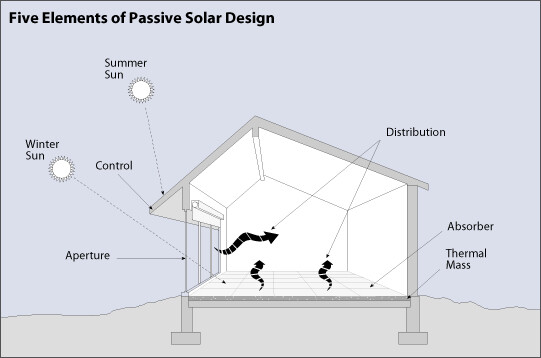
This kind of ‘outside-the-box’ but eminently sensible thinking about solar power will help PV on its march toward grid parity. As most of the SBDC Conference speakers were keen to point out, solar power modules that perform multiple functions or that replace other materials in a structure will save on the cost of construction, even if the cost of using PV-capable replacements is higher than the conventional materials. The Solarseeds blog refers to a comment by Dr Douglas Dudis, a researcher with the US Air Force Research Laboratory, Materials and Manufacturing Directorate, who at the ASES (American Solar Energy Society) 2007 Solar Conference stated that along with material availability issues and high labour requirements involved in PV technology manufacturing, a major factor contributing to PV’s relative unaffordable nature compared to conventional energy sources was lack of building integration. So the next question is, in what ways can integration happen?
Forms of BIPV
Roof tiles and shingles
Conventional solar panels are commonly retrofitted onto the roofs of homes and other buildings at an added expense: they require special mounting brackets and expertise. One of the easiest places to begin for a broad-scale implementation of BIPV is ceramic or clay roof tiles, which are rigid, and asphalt shingles, which are flexible. 3-S Photovoltaics, a German company whose managing director Christian Renken gave a talk at the SBDC Conference, has developed a range of tile-type modules that are frameless, of regular size, can be installed by any roofer, and can be interspersed with tiles of the same size but different functionality, such as thermal collectors and skylights, as well as standard roof tiles. Similarly, Uni-Solar has manufactured a Power Shingle(TM) that can be seamlessly integrated into shingled roofs, secured in the same way that traditional shingles are secured–using nails.
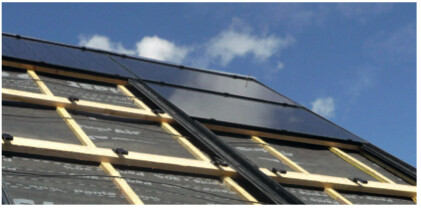

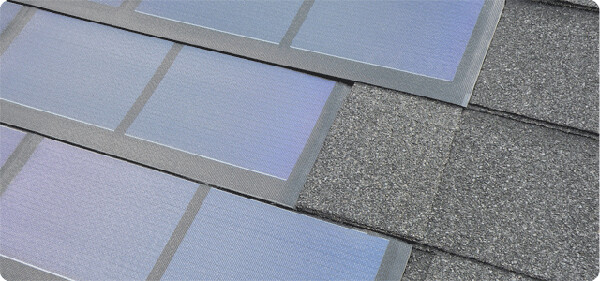
These are just two examples of what is available in the European and American roof-integrated solar power generation markets at the moment. Similar panels from other manufacturers have also come into production, as a quick Google search for ‘BIPV solar tiles’ or ‘BIPV solar shingles’ will give you some idea of what is available. One product similar to PV shingles and tiles on the market is PV laminates–thin-film PV that can be attached to the surface of parts of buildings, including roofs. Its superficial nature, however, may exclude it from the definition of BIPV outlined in the previous section–it is usually bonded on after the fact. Laminates are extremely versatile, however, which makes them ideal for retrofitting.
Solar facades, curtains, awnings, and windows
Another way that photovoltaics can be integrated into a building is in the walls of the building itself, or sometimes more effectively, in a multi-purpose ‘skin’ or curtain that surrounds the ‘core’ building inside of it. As with all BIPVs, here too the solar cells serve a dual purpose. As Ray Noble pointed out in his presentation for the SBDC Conference, if the PV modules are price-competitive with conventional building materials and are intelligently crafted into the building design, then the cells don’t need to have optimum orientation–any direction besides the poleward direction (north or south, depending on your hemisphere) will generate electricity with up to 90% the rated efficiency. In other words, modules don’t need to be placed on the roof.
There are a few options available in determining what to do with your PV in sections of the building besides the roof. These are roughly explained below. How their installation is implemented depends on the sensibility of the designer.
-Integrate into the walls. Perfectly vertical walls, of course, do not receive the same solar radiation the way slanted or horizontal roofs do, but they do receive some, especially if the building is located in the higher latitudes, where the winter sun comes in at low angles. ‘Perforated’ modules are available that will capture a portion of light for electricity production in the cells, while simultaneously allowing some light to transfuse into the building.
-Integrate the modules into a building’s surrounding ‘skin’. Some buildings incorporate such a skin for aesthetics as well as for climate control purposes. If the panels were, much like windows, capable of opening and closing, they could play a direct role in controlling the climate of the building, while at the same time having enough space to keep cool and therefore function efficiently

-Solar awnings, as discussed previously, are advantageous in that they can keep the unwanted direct rays of the sun out of your eyes while absorbing them to create electricity. The angle of awnings could potentially be adjusted to best capture/block the rays of the sun depending on the season.

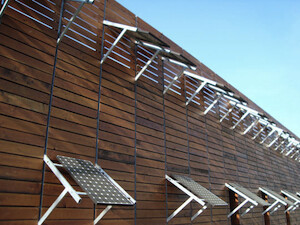
-Solar windows (PV glazing) and skylights serve the same purpose as their ordinary counterparts–to let in light, reduce glare (if they are tinted), and act as insulation for or means of providing ventilation within a building.
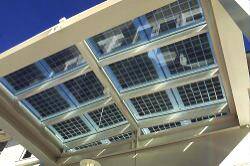
Some of the most fascinating and innovative techniques for passive solar are under development for the non-roof building parts mentioned above. Simone Giostra, founding partner of Simone Giostra & Partners and one of the other speakers at the SBDC Conference, referred to some of the technologies now under development as akin to science fiction: precision of an unprecedented level to integrate PV cells into the facades of buildings, increasing cell density where sunlight is expected to fall most intensely, decrease it where sunlight is expected to be sparser. This would enable the optimum capture of solar energy for both electricity generation and lighting/climate purposes. Whether doing something so complicated is practical or cost-effective or not is at present questionable, but that the technology is being developed is praiseworthy.
BIPV vs Conventional PV in a Nutshell
Provided that the cost of the newer BIPV technologies continues to fall, and that the building under consideration has yet to be built or is going to be a major renovation, BIPV will most likely be the first, most obvious choice for the designer/architect. Conventional PV panels win out where the building is older and the installation is a retrofit, and where the price is a consideration. That being said, the BIPV technology that is most likely to take off in the retrofit market is BIPV roofing–especially on homes that need roof replacements anyhow.
The following is a summary of the Pros and Cons of BIPV and conventional solar PV.
Conventional ‘panel’ PV:
+Relatively commonplace throughout the world, including in Australia, and therefore plenty of infrastructure
+Durable and time-tested–will continue to function at more or less rated capacity for up to 25 or 30 years
+Industry standards have been developed and are well-known to experienced installers
+Efficiency of panels has been steadily increasing while the price has been decreasing
+Can easily be installed on top of a roof on a building that does not require any structural overhaul
-Big, rectangular, visually unappealing (to some people! I suppose this is a matter of taste…)
-Does not ‘add value’ to a home’s functionality besides electricity production
-Placement options are limited–generally either on top of a roof or possibly ground-mounted
BIPV:
+Value-added! Well-designed BIPV generates electricity while improving the climate performance of your home/building
+Can replace almost all external building materials and thereby reduce the long-term overall costs of a building via operational cost savings and reduced embodied energy
+Aesthetically pleasing–can be seamlessly integrated into the building envelope to give a sleek, modern look to a building (e.g. some of the pictures that accompany this blog entry!)
-Smaller market, many technologies are still under development and are not price-competitive on the retail scale with conventional panels
-Infrastructure, standards not in place, expertise needs to be built up (in Australia, among other places outside the EU)
-If some forms of amorphous PV are used in building, the productivity of the PV may decline in as little as 10 years–amorphous generally has a life span that is shorter than crystalline PV
The standard for solar power in the EU, the future of solar power for the world?
As discussed in this article, the importance of BIPV in architecture will continue to increase in the future. According to two articles from Solarserver.com and Renewableenergyworld.com, the future of the BIPV market is bright. Consulting group Frost and Sullivan predict that it will expand 108% by 2016, reaching a worth of 2.7 billion dollars. The growth is attributable in large part to the generous and strategic financial incentive mechanisms in place in the EU for renewable energy, including feed-in tariffs and tax incentives. As with conventional PV, the ultimate aim of these incentives is to accelerate the growth of the industry, eventually bringing PV-generated electricity prices closer to those produced by traditional sources such as coal, but without the negative side effects. Once the holy grail of grid parity is achieved, BIPV will likely come to be seen as standard practice when it comes to new construction and major renovations.
Addendum: In another industry analysis report discussed in an article on Enhanced Online News, Market Research Consulting Firm Pike Research has projected that the worldwide BIPV market will grow to $4b by 2016, with the price per Watt becoming as low as $2.50.
Written by James Martin
Solar Choice Analyst
3-S Photovoltaics homepage
ASES homepage
Australian Government: Your Home Technical Manual (BIPV)
Energysavers.gov: “Five elements of passive solar home design“
PV Glazing (solar windows) photos from ECW.org
Solar in Building Design and Construction (Based on notes from the 24 September 2010 Solar in Building Design and Construction Conference)
Solarseeds.blogspot.com: Building-integrated photovoltaics
Solarserver.com: “Frost and Sullivan project European BIPV market to reach EUR 2.70 billion in 2016”
Renewableenergyworld.com: BIPV Market in Europe Showing growth
Todaysfacilitiesmanager.com: “The state of Solar Photovoltaics”. (Top image also from this site)
Miwa Tominaga: “Opportunities for thin film photovoltaics in Building Integrated Photovoltaics (BIPV) with a focus on Australia” (pdf), Dissertation for Master of Science in Renewable Energy School of Energy and Engineering, Murdoch University, 2009.
Treehugger.com, “New Solar Photovoltaic Window System Announced by RSi Solar”
Uni-Solar homepage (Power Shingle(TM) photos from this site)
Previous Solar Choice blog entries: Asbestos in my roof! Can I install solar panels? (solar panel awnings) : Feed-in Tariffs : Which type of solar panel suits your needs?
- Solar Hot Water System: Everything You Need to Know - 27 February, 2024
- Enphase Battery: An Independent Review by Solar Choice - 20 January, 2024
- Can I add more panels to my existing solar system? - 8 August, 2023
we are wanting to put solar panels up as the awnings over our north windows on a home renovation in perth western Australia. Do you know o any western Australian suppliers that may have this technology- we are finding it very difficult to find someone who can do it and integrate it into a rooftop system also. Thanks
Hi Nicole,
The best way to go about finding out if there are any installers in our network who would provide this sort of service would be to fill out our Quote Comparison Request form to the right of this page. We do work with a number of installer in Perth, and some of them may be able to assist you.
Best of luck!
How can I purchase some of your panels.
Hi Shawn,
We don’t sell panels or solar PV systems–read more about what we do.
Does Solar Choice have the know-how and resources to design BIPV systems?
Thanks for the comment, James. Solar Choice does indeed have an experienced and highly qualified in house architect and consultant who is able to design BIPV solutions. Please send an email to sales@solarchoice.net.au in order to commence discussions on what design may be appropriate for you.